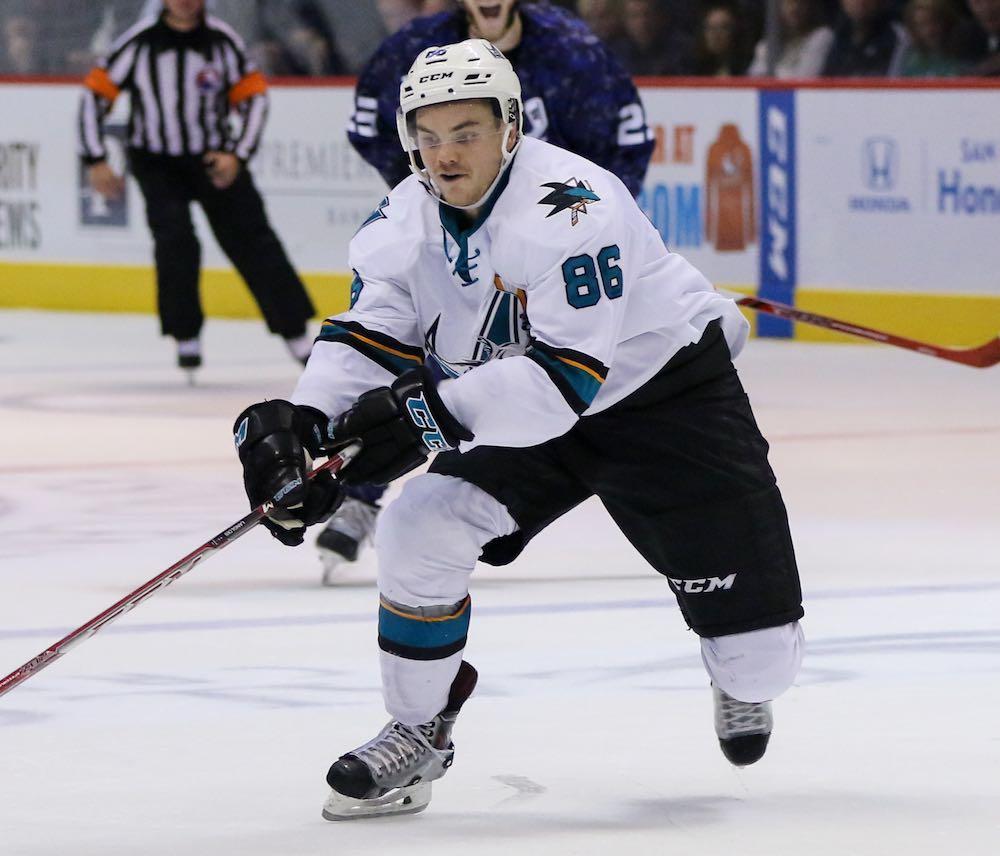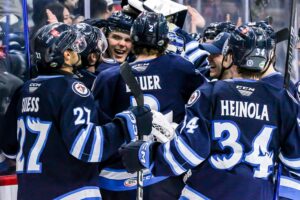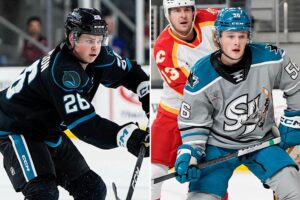by Paul Gackle | AHL On The Beat Archive
After taking an unconventional path to professional hockey, everything seemed to be coming together for San Jose Barracuda forward Jeremy Langlois during his rookie season in the AHL last winter.
Langlois quickly earned a spot on the Worcester Sharks’ top line, he led the team in goal scoring midway through the season and seemed destined to get a sniff of NHL action at some point down the road.
Then, he blocked a shot with his right ankle late in the second period of a game against the Providence Bruins on Jan. 31.
“I didn’t think anything was wrong and then I skated back to the bench and just knew right away that it was broken,” Langlois said.
“It was [devastating]. I’d worked my way up, and I was at the point where I was playing well and the team was doing well and you just want to be able to contribute.”
Langlois managed to rehab his way back into the Sharks lineup just in time for the Calder Cup Playoffs, but he wasn’t himself, lacking his trademark explosiveness on the puck. In fact, he didn’t truly return to form until he strung together a four-game point streak earlier this month (Nov. 8- Nov.14), leading the Barracuda’s offensive charge with three goals and two assists.
“I hadn’t seen the real [Langlois] until the last four, five or six games. Now, you’re seeing what he can do,” Barracuda head coach Roy Sommer said. “When he’s on the ice, watch out.”
First, the hockey world gave us Maurice “Rocket” Richard, then his brother, Henri “the Pocket Rocket” Richard joined the NHL. If Langlois ever cracks the league, puckheads will also get a taste of the “Cactus Rocket.”
“I don’t know who gave him that name, maybe it was [former Sharks goalie coach] Wayne Thomas,” Sommer said. “He’s the Cactus Rocket because he’s from Phoenix.”
Just as kids across Northern California started playing hockey after the Sharks joined the NHL back in 1991, Langlois benefited from the Winnipeg Jets’ move to Phoenix in 1996. After playing roller hockey throughout his early childhood, Langlois made the transition to the ice at around age 10 after hockey rinks started popping up in the desert as a result of the NHL’s arrival in Arizona.
But Langlois knew he’d eventually need to move out east in order to advance his hockey career, so he joined the EJHL’s New Jersey Hitmen (junior hockey) during his senior year of high school, where he found his way onto Quinnipiac University’s radar.
Although Quinnipiac lacked the hockey tradition of schools like Michigan, North Dakota and Boston College, Langlois quickly made a name for himself in the NCAA circuit, earning the team’s rookie of the year award during his freshman season and leading the squad in goal-scoring during his sophomore and junior years.
In 2012-13, his senior year, Langlois led Quinnipiac to its first appearance in the Frozen Four and the team advanced to the national championship game.
Ironically, Quinnipiac wound up losing to Barracuda teammate Gus Young’s Yale squad, so Langlois was often reminded of his team’s misfortune when the two were roommates in Worcester last season.
“Early in the year, I was a little hesitant. I didn’t know him too well,” Young said, referring to bringing up his victory in the NCAA title game. “But as the year went on, if I needed to get the upper hand in an argument, I would always feed it to him a little bit.”
Langlois’ success at the NCAA level translated quickly to professional hockey during the 2013-14 season. As an ECHL rookie, he earned an invitation to the league’s All-Star game and finished 12th in scoring with 60 points in 56 games.
The 25-year-old forward joined the Worcester Sharks during his second season of pro hockey last year and turned heads at Sharks training camp in the fall with his explosive speed and soft touch.
“He came into camp last year and opened everyone’s eyes,” Sommer said. “He was just one of those kids that got better, better and better, and once he got going [during the AHL season] he was pretty hard to stop. He got a breakaway or two a game and was starting to finish before he broke his ankle. That really set him back.”
Despite missing 32 games because of the injury, Langlois still finished second on the team in goal scoring with 16 tallies.
“He’s one of the fastest guys in the American League,” linemate Bryan Lerg said.
After a slow start to the 2015-16 season, Langlois started to catch fire after scoring a goal just 35 seconds into the Barracuda’s game against the Bakersfield Condors on Nov. 8. He continued to find the scoresheet after Sommer reunited him with Lerg and added Ryan Carpenter into the mix when the squad traveled to Southern California on Nov. 11.
Now, the Langlois-Lerg-Carpenter line is leading the charge for the Barracuda, collecting a combined 11 points in four games while the team earned five of a possible eight standings points.
“All of a sudden our team’s starting to figure it out a little bit and he’s one of our best players,” Lerg said. “He just has to play the way he has with his speed and let me and [Carpenter] complement him. Me and Langer know where each other are on the ice without even talking. We’re just natural together.”
Like every AHL player, Langlois’ ultimate objective is to earn an invitation to play for the Sharks in the NHL. But he knows that his game still needs to mature before he’s going to get his number called and he’s ready to put in the necessary work to get there.
“You definitely need to be better defensively, you need to be able to go up there and kill penalties and not give up goals,” Langlois said. “I think that’s the main thing when you’re up there, you won’t get called up and play first or second line. You have to work your way up and that means getting the coaches to trust you.”
But for now, Langlois is pleased that his game is returning to its 2014-15 form. He’s currently ranked tied for second on the Barracuda in scoring with eight points (5g, 3a).
“I feel a lot more comfortable on the ice,” he said. “I hadn’t really played seriously since I broke my foot at the end of January, so to get back to stride and feel good in the games and feel comfortable with the puck, that’s a good thing.”






































